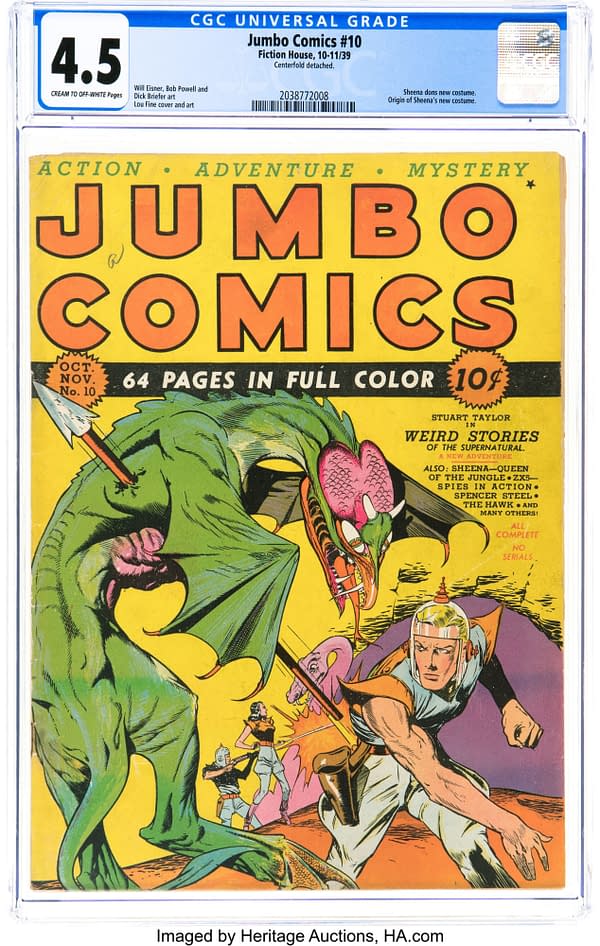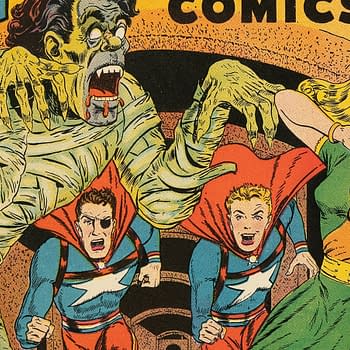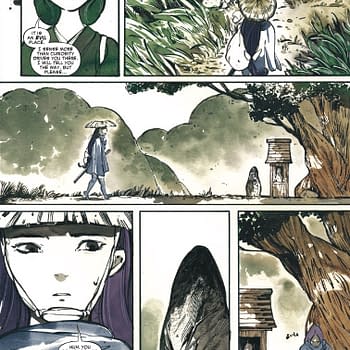Posted in: Comics, Heritage Sponsored, Vintage Paper | Tagged: fiction house, Jumbo Comics, sheena
The Origin of Sheena's Iconic Costume in Jumbo Comics #10, at Auction
Sheena didn't always wear her now-iconic plunging neckline leopard skin outfit, and the story of Jumbo Comics #10 explains how she got it.
Sheena's iconic leopard skin costume with its plunging neckline front and mostly backless design has become so familiar and ubiquitous, that it's hard to imagine that the character ever wore anything else. But she did, and there's even an early moment in the Jumbo Comics series that explains the change to the now-familiar design. For the first eight issues of its run, Fiction House's Jumbo Comics was essentially a tabloid-sized 10.5" x 14.5" and also had black and white interiors. Jumbo Comics #9 shrinks to 8.25" x 10.25" (still wider than a standard Golden Age comic book) and changes to full color. Finally, Jumbo Comics #10 becomes a standard-sized (and also full-color) Golden Age comic book. Jumbo Comics #10 also tells us the story behind Sheena's now-legendary costume, and there's a Jumbo Comics #10 (Fiction House, 1939) CGC VG+ 4.5 Cream to off-white pages up for auction in the 2023 October 19 The Fiction House Comics & Comic Art Showcase Auction #40235 at Heritage Auctions.

As experienced collectors will know, there's a bunch to unwrap in regard to any early Sheena first appearances or developments, so let's tackle that first. The character was created by Will Eisner, Jerry Iger, and Mort Meskin at the behest of a publisher called Editors Press Service. Sheena debuted in a one-page feature in the UK weekly tabloid Wags #46, which according to GCD is dated January 14, 1938. It is perhaps worth pointing out that nobody seems to know of the current existence of a copy of this issue, and that the early issues of Wags (there's also an Australian version, which apparently differs from the UK version) are sparsely documented at best. According to historian Denis Gifford in the International Book of Comics, which seems to be the best reference on this matter, Editors Press Service split with its UK agent, who took the British rights to many of the syndicated reprints that Wags contained with him, causing Editors Press Service to seek out original material. Editors Press Service's founder turned to Jerry Iger, who he had apparently become acquainted with during the brief run of Wow What A Magazine in 1936.
Wags publisher Editors Press Service was founded by Joshua B. Powers in 1933. In a tidbit that seems to have been sourced from the comics history book Men of Tomorrow and widely repeated since, apparently Jerry Iger was under the impression that Powers was a former U.S. government covert agent who had operated in South America. Based on a few surrounding facts, this does not seem unlikely, though perhaps not "former." At its founding in 1933, Editors Press Service's editor was Carlos Dávila, who seems to have come to this job directly from his previous gig of having assumed power as the Provisional President of Chile in the wake of the anarchy that existed in that country following the resignation of President Carlos Ibáñez del Campo. In a 1977 article on the CIA's worldwide propaganda network, the New York Times outed Editors Press Service as a CIA front for the dissemination of propaganda and Powers himself as a CIA officer.
A rare and important early Fiction House comic, there's a Jumbo Comics #10 (Fiction House, 1939) CGC VG+ 4.5 Cream to off-white pages up for auction in the 2023 October 19 The Fiction House Comics & Comic Art Showcase Auction #40235 at Heritage Auctions. New to collecting Fiction House or want to learn more? Bleeding Cool is doing an ongoing deep dive into the history behind Fiction House in the run-up to this auction. If you've never bid at Heritage Auctions before, you can get further information, you can check out their FAQ on the bidding process and related matters.

















